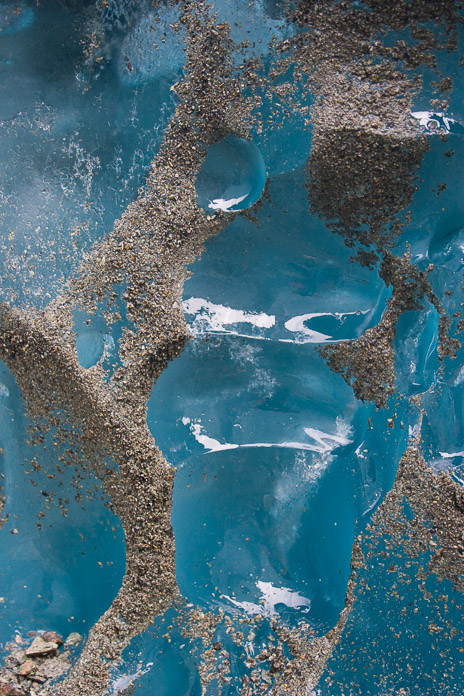- Todas
- Tierra salvaje
- Glaciares
- Fauna
- Pueblos
- Postales

Una de las preguntas más comunes de los visitantes de Glacier Bay es: "¿Qué hace que el hielo sea azul?" El hielo es azul porque ese es su verdadero color. Este color se ve porque el hielo es puro, lo que permite que la luz penetre lo bastante como para que los tonos rojos, amarillos, y violetas sean absorbidos de manera distinta por el espectro de luz, dejando que los azules y verdes se transmitan de regreso a nuestros ojos. El hielo se ve blanco cuando contiene demasiadas burbujas de aire que dispersan la luz antes de que pueda ser absorbida por el hielo. Este ejemplo es del fondo de Lamplugh Glacier (glaciar Lamplugh). Acampé cerca de la base del glaciar y, mientras exploraba su eje, fui capaz de moverme con seguridad hasta una grieta (una grieta muy grande). Me gusta el patrón abstracto que se crea por el contraste de la arena y el hielo azul, así como la ambigüedad de su escala. Esta foto abarca solamente 0,45 metros cuadrados de hielo.
One of the most common questions from visitors to Glacier Bay is, “What makes the ice blue?” The ice is blue because that is its true color. This color is expressed because the ice is pure, which allows the light to penetrate sufficiently far that the reds, yellows and violets are differentially absorbed from the light spectrum, leaving the blues and greens to be transmitted back to one’s eye. Ice looks white when it contains too many air bubbles that scatter the light back before it can be differentially absorbed by the ice. This example came from the bottom of Lamplugh Glacier. I was camped near the base of the glacier and while exploring its edge, I was able to safely maneuver to a crevasse (a large crack). I liked the abstract pattern created by the sand contrasted against the blue ice, as well as the ambiguity of the scale. This photo frames only about five square feet of ice. Photographer: Sean Neilson